
Quassia is a plant genus in the family Simaroubaceae. Its size is disputed; some botanists treat it as consisting of only one species, Quassia amara from tropical South America, while others treat it in a wide circumscription as a pantropical genus containing up to 40 species of trees and shrubs.

Xanthium (cocklebur) is a genus of flowering plants in the tribe Heliantheae within the family Asteraceae, native to the Americas and eastern Asia and some parts of south Asia.
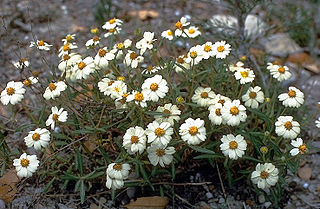
Melampodium is a genus of flowering plants in the sunflower family.

Carl Ernst Otto Kuntze was a German botanist.

Physocarpus, commonly called ninebark, is a genus of flowering plants in the family Rosaceae, native to North America and northeastern Asia.

Acanthospermum is a genus of plants in the family Asteraceae, also known as starburrs or starburs. It was described as a genus in 1820.
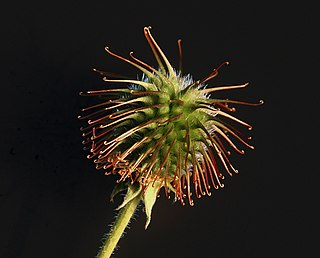
A bur is a seed or dry fruit or infructescence that has hooks or teeth. The main function of the bur is to spread the seeds of the bur plant, often through epizoochory. The hooks of the bur are used to latch onto fur or fabric, enabling the bur – which contain seeds – to be transported to another location for dispersal. Another use for the spines and hooks are physical protection against herbivores. Their ability to stick to animals and fabrics has shaped their reputation as bothersome.
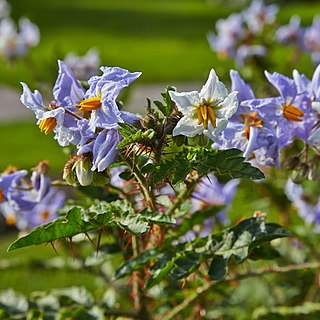
Solanum sisymbriifolium is commonly known as vila-vila, sticky nightshade, red buffalo-bur, the fire-and-ice plant, litchi tomato, or Morelle de Balbis.

Bothriochloa is a common and widespread genus of plants in the grass family native to many countries on all inhabited continents and many islands. They are often called beardgrass, bluegrass or bluestem. Some species are invasive in areas where they have been introduced.

Senecio crassiflorus, in Portuguese: margarida-das-dunas, one of the native South American Senecio and an herbaceous dune dwelling perennial.

Luziola (watergrass) is a genus of New World in the grass family, native to North and South America including the West Indies.
Radlkoferotoma is a genus of South American flowering plants in the family Asteraceae.
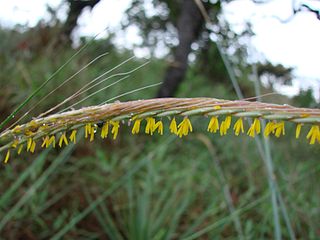
Trachypogon is a small genus of African and Latin American plants in the grass family. Crinkleawn grass is a common name for plants in this genus.

Pappophorum is a genus of plants in the grass family, native to the Western Hemisphere. Members of the genus are commonly known as pappusgrass.

Sphagneticola is a genus of flowering plants in the family Asteraceae. Creeping-oxeye is a common name for plants in this genus.
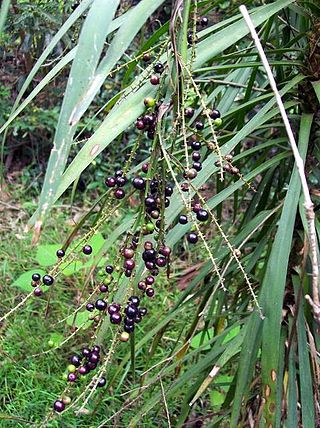
Cordyline stricta, known as the slender palm lily, or narrow-leaved palm lily is an evergreen Australian plant. A shrub to 5 metres tall found in wet sclerophyll forest and rainforest, usually on the coastal lowlands. From near Bilpin, New South Wales further north to Queensland. C. stricta has become naturalised in Victoria.

Kalmia hirsuta, the hairy mountain-laurel, is a plant species native to the southeastern United States. It is reported from Florida, Georgia, Alabama and South Carolina. It grows in open, sandy locations such as savannahs, sand hills and pine barrens at elevations of less than 100 m (330 feet).

Dimerocostus is a group of flowering plants in the Costaceae described as a genus in 1891. It is native to Central and South America.
Schoenoplectus etuberculatus, common name Canby's bulrush, is a plant species native to the United States. It is reported from every state on the Gulf and Atlantic coasts from eastern Texas to Delaware, plus isolated populations in Rhode Island and Missouri. It is an emergent plant growing in ponds, marshes, stream banks, etc., including in brackish water along the coast.

Allenrolfea is a genus of shrubs in the family Amaranthaceae. The genus was named for the English botanist Robert Allen Rolfe. There are three species, ranging from North America to South America.



















